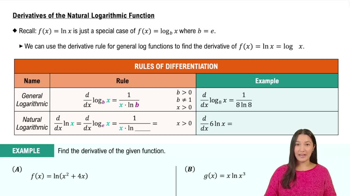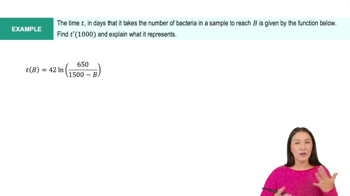Table of contents
- 0. Functions7h 52m
- Introduction to Functions16m
- Piecewise Functions10m
- Properties of Functions9m
- Common Functions1h 8m
- Transformations5m
- Combining Functions27m
- Exponent rules32m
- Exponential Functions28m
- Logarithmic Functions24m
- Properties of Logarithms34m
- Exponential & Logarithmic Equations35m
- Introduction to Trigonometric Functions38m
- Graphs of Trigonometric Functions44m
- Trigonometric Identities47m
- Inverse Trigonometric Functions48m
- 1. Limits and Continuity2h 2m
- 2. Intro to Derivatives1h 33m
- 3. Techniques of Differentiation3h 18m
- 4. Applications of Derivatives2h 38m
- 5. Graphical Applications of Derivatives6h 2m
- 6. Derivatives of Inverse, Exponential, & Logarithmic Functions2h 37m
- 7. Antiderivatives & Indefinite Integrals1h 26m
- 8. Definite Integrals4h 44m
- 9. Graphical Applications of Integrals2h 27m
- 10. Physics Applications of Integrals 2h 22m
6. Derivatives of Inverse, Exponential, & Logarithmic Functions
Derivatives of Exponential & Logarithmic Functions
Problem 3.9.30
Textbook Question
Find the derivative of the following functions.
y = In(cos² x)
 Verified step by step guidance
Verified step by step guidance1
First, recognize that the function y = ln(cos²(x)) is a composition of functions. It involves the natural logarithm function ln(u) where u = cos²(x).
Apply the chain rule for differentiation, which states that if y = ln(u), then dy/dx = (1/u) * du/dx. Here, u = cos²(x).
Differentiate u = cos²(x) with respect to x. Use the chain rule again: if u = (cos(x))², then du/dx = 2 * cos(x) * (-sin(x)), because the derivative of cos(x) is -sin(x).
Substitute du/dx into the chain rule formula: dy/dx = (1/cos²(x)) * (2 * cos(x) * (-sin(x))).
Simplify the expression: dy/dx = -2 * sin(x) / cos(x), which can be further simplified to dy/dx = -2 * tan(x), using the identity tan(x) = sin(x)/cos(x).
 Verified video answer for a similar problem:
Verified video answer for a similar problem:This video solution was recommended by our tutors as helpful for the problem above
Video duration:
7mPlay a video:
Was this helpful?
Key Concepts
Here are the essential concepts you must grasp in order to answer the question correctly.
Derivative
The derivative of a function measures how the function's output value changes as its input value changes. It is a fundamental concept in calculus that provides the slope of the tangent line to the curve of the function at any given point. The derivative is often denoted as f'(x) or dy/dx and can be calculated using various rules, such as the power rule, product rule, and chain rule.
Recommended video:

Derivatives
Chain Rule
The chain rule is a formula for computing the derivative of the composition of two or more functions. It states that if you have a function y = f(g(x)), the derivative can be found by multiplying the derivative of the outer function f with the derivative of the inner function g. This rule is essential when differentiating functions that are nested within each other, such as logarithmic and trigonometric functions.
Recommended video:

Intro to the Chain Rule
Logarithmic Differentiation
Logarithmic differentiation is a technique used to differentiate functions that are products or quotients of variables raised to powers. By taking the natural logarithm of both sides of the equation, it simplifies the differentiation process, especially when dealing with complex functions. This method is particularly useful for functions involving exponential growth or decay, as well as for simplifying the differentiation of products of functions.
Recommended video:

Logarithmic Differentiation

 4:50m
4:50mWatch next
Master Derivatives of General Exponential Functions with a bite sized video explanation from Callie
Start learningRelated Videos
Related Practice














